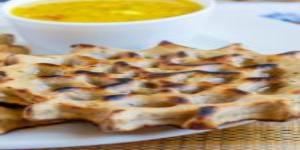
Fundamental Concepts and Principles
The primary ingredients in rotis/pancakes are stone ground flour, salt (optional), and water to form the dough. Rotis are made into savories with the use of jaggery, coconut, etc.
- ½ padi Milk
- 1¼ palam Khameer
- 5 palam Cream of Milk
- ½ padi Wheat Grits
- ¼ palam Salt
- veesam 1/16 padi Curd
- veesam 1/16 padi Milk
1. Combine milk and khameer and mix them well.
2. Combine cream of milk and wheat grits. Add salt to it.
3. Now add the milk and kameer mixture to the grits mixture. Mix it gently and knead it into a soft pliable dough.
4. Leave this dough for sometime without disturbing it. After some time it would have risen in volume. Then take a lemon size ball from the dough and roll it into a thin circle of half inch thickness.
5. Combine the curd and milk together and spread this mixture evenly on all the roti’s.
6. Place all the roti’s on a clean wet cloth and cover it with a wet cloth for 36 minutes.
7. After 36 minutes, they would have puffed up. Then make 2 to 3 holes on the center of the roti and cook it.
8. Sprinkle sour buttermilk on the roti till it is slightly red and has puffed up.
9. Once the center portion gets cooked put the roti on a live coal without smoke so that the edges get cooked.
Method
A roti dough is rolled out into flat round, square or triangular shapes, and cooked on a flat or slightly concave iron (or clay) griddle called a tawa. There are also a variety of rotis made using a traditional Indian oven called the tandoor, especially in the state of Punjab, where the flattened dough is stuck to the inside wall of the tandoor, where it bakes quickly at a high temperature. In everyday life and homes, the roti rolled out is called chapati and is made of whole wheat flour mixed into dough with water, edible oil or ghee and optional salt in a mixing utensil called a parat, and is cooked on the tava. Variations of the chapati include the phulka (in Punjab, Maharashtra, Gujarat) and maani in Sindhi.
Some roti recipes do use a home-made souring process called khameer, as also buttermilk, yoghurt, etc., for variety and healthier options.
Hindu Compliance Body
The Hindu compliance body was established under the executive order of The Supreme Pontiff of Hinduism, dated August 14, 2020, order number 10010, under the title Reviving the Hindu Compliance System and Body
to create, promote, spread and teach the standard procedures for all products and services that are in compliance Hindu Shastras.
Copyright
HCS has the copyright of all its publications. No part of these publications may be reproduced in any form without the prior permission in writing to HCS. This does not preclude the free use, in the course of implementing standard, of necessary details mentioned above. Enquiries related to copyrights to be addressed to KAILASA.
